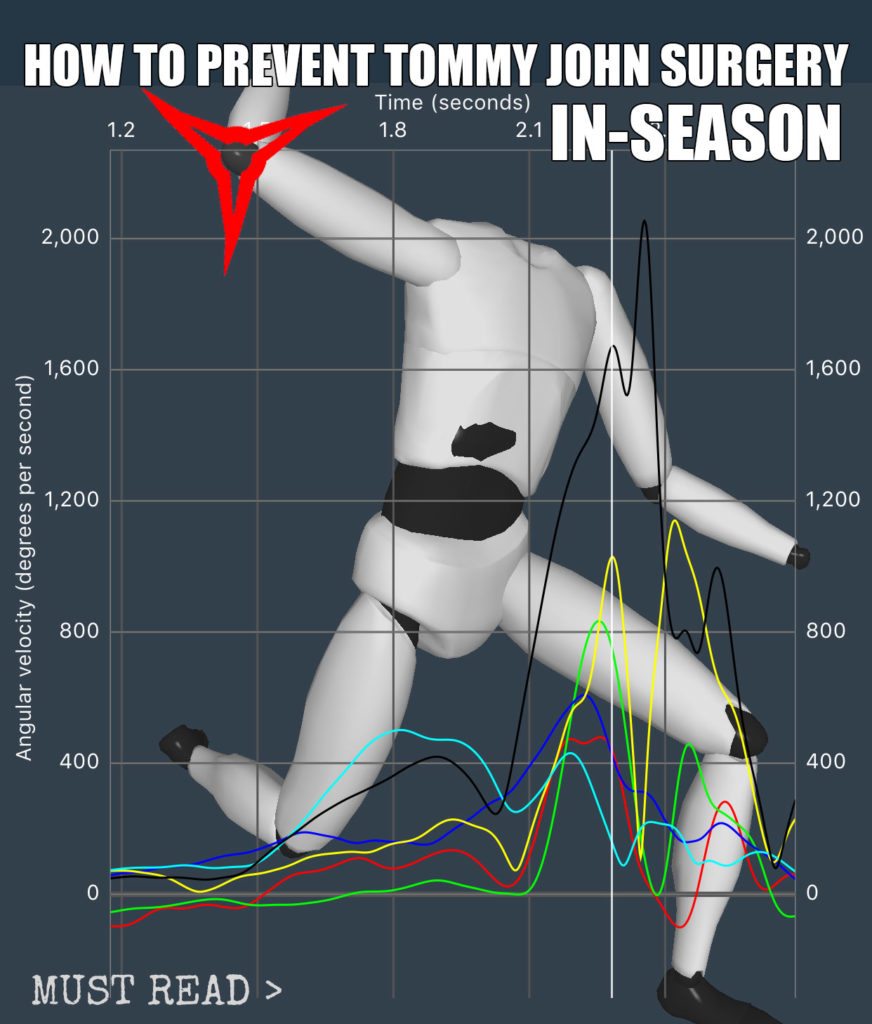
Preventing Tommy John surgery is at high demand in the game of baseball due to the commonality of the surgery. This article will look at what it takes to prevent Tommy John surgery. Evidence suggests that the elbow is a link in the kinetic chain which is best used to regulate and transfer force to the baseball (Kibler & Sciascia, 2004). Therefore, the elbow is less vulnerable to injury when the shoulder and the rest of the body work together to generate energy and optimize performance. Kibler and Chandler (1995) went even farther to suggest, that through the kinetic chain, a 20% decrease in kinetic energy delivered from the hip and trunk to the arm requires a 34% increase in the rotational velocity of the shoulder to impart the same amount of force to the hand. Therefore, the key to preventing ulnar collateral ligament (UCL) damage biomechanically is better using the entire kinetic chain.
Factors to Prevent Tommy John Surgery
Here is the best-detailed explanation I can find on how the kinetic chain can prevent tommy john surgery. Evidence suggests that the valgus stress that hits the arm per pitch for an adult is around 64Nm (Fleisig, Andrews, Dillman, & Escamilla, 1995). This requires a counter varus torque of 64Nm to resist this massive torque. This is like holding 150 baseballs that weigh 5 ounces each. The UCL can only handle about 34Nm of the counter varus torque before it ruptures (Morrey, & An, 1983). This means the anterior band of the anterior bundle is the first line of defense to the valgus stress at 30°, 60°, and 90° of elbow flexion. The stress on the anterior band increases as the angle becomes greater where 90° is forced to handle 55% of the force of the valgus stress and 78% of the force of elbow distraction. This is important to note because when the throwing arm is experiencing maximum valgus stress when in maximum external rotation during the late cocking and early acceleration phase the throwing arm is around 90° of flexion. The greatest stress the UCL can handle before it is damaged is around 33Nm. This means every pitch has the potential to damage or rupture the UCL. Even though the stress per pitch is enough to tear the ligament in the medial side of the elbow, injuries or not as common as they should be. This is due to the dynamic stabilizers like the triceps, anconeus, flexor-pronator mass and the internal rotators of the shoulder (Conway, Jobe, Glousman, & Pink, 1992).
The two key muscles that are important to help protect the elbow through the high risk sequences of the arm path are the flexor carpi ulnaris (FCU) and flexor digitorum superficialis (FDS). The FCU is optimally placed to provide significant support to the UCL (Jobe, & Kvitne, 1991). Even more, evidence suggests from a biomechanical analysis that generated kinematic data that the flexo-pronator mass mainly the FCU was the key dynmic stabilizer of the joint (Park, & Ahmad, 2004). It is important to note that electromyography (EMG) studies have discovered decreased activity of the pronator teres and FCU in pitchers with UCL insufficiency (Hamilton et al., 1996). These studies help paint the picture that the flexor-pronator mass is the key line of defense against UCL damage. This means it is critical for pitchers to strengthen this musculature to optimize its dynamic role which will have a significant impact against future risk of injury.
Biomechanics to Prevent Tommy John Surgery
Clinical evidence suggests from a biomechanical analysis how critically important the shoulder is to protecting the elbow from injury (Marshall, & Elliott, 2000). The key biomechanical movement to protecting the elbow from valgus torque by applying a counter varus torque is internal rotation of the shoulder. A study found that the loads generated during varus torque at the elbow was 64Nm along with 67Nm of internal rotation torque and 310N of anterior force at the shoulder (Fleisig, Andrews, Dillman, & Escamilla, 1995). The combination of shoulder internal rotation and forearm pronation is what makes up the magnitude of varus counter torque that protects the elbow from the massive amount of valgus elbow stress that is the source of most UCL damage. This means it is critical for a pitcher to strengthen the internal rotators like the latissimus dorsi, the pectoralis major and minor and subscapularis.
Reference to Prevent Tommy John Surgery
Conway, J. E., Jobe, F. W., Glousman, R. E., & Pink, M. (1992). Medial instability of the elbow in throwing athletes. Treatment by repair or reconstruction of the ulnar collateral ligament. The Journal of bone and joint surgery. American volume, 74(1), 67-83.
Fleisig, G. S., Andrews, J. R., Dillman, C. J., & Escamilla, R. F. (1995). Kinetics of baseball pitching with implications about injury mechanisms. American Journal of Sports Medicine, 23(2), 233-9.
Hamilton, C. D., Glousman, R. E., Jobe, F. W., Brault, J., Pink, M., & Perry, J. (1996). Dynamic stability of the elbow: electromyographic analysis of the flexor pronator group and the extensor group in pitchers with valgus instability. Journal of Shoulder and Elbow Surgery, 5(5), 347-54.
Jobe, F. W., & Kvitne, R. S. (1991). Elbow instability in the athlete. Instructional course lectures, 4017-23.
Kibler, W. B., & Chandler, J. (1995). Baseball and tennis. In: Griffin LY, editor, ed., 219-226.
Kibler W. B., & Sciascia, A. (2004). Kinetic chain contributions to elbow function and dysfunction in sports. Clinical Sports Medicine, 23(4), 545-52.
Marshall, R. N., & Elliott, B. C. (2000). Long-axis rotation: the missing link in proximal-to-distal segmental sequencing. Journal of Sports Sciences, 18(4), 247-54.
Morrey, B. F., & An, K. N. (1983). Articular and ligamentous contributions to the stability of the elbow joint. American Journal of Sports Medicine, 11(5):315-9.
Park, M. C., & Ahmad, C. S. (2004). Dynamic contributions of the flexor-pronator mass to elbow valgus stability. The Journal of bone and joint surgery. American volume, 86-A(10), 2268-74.



